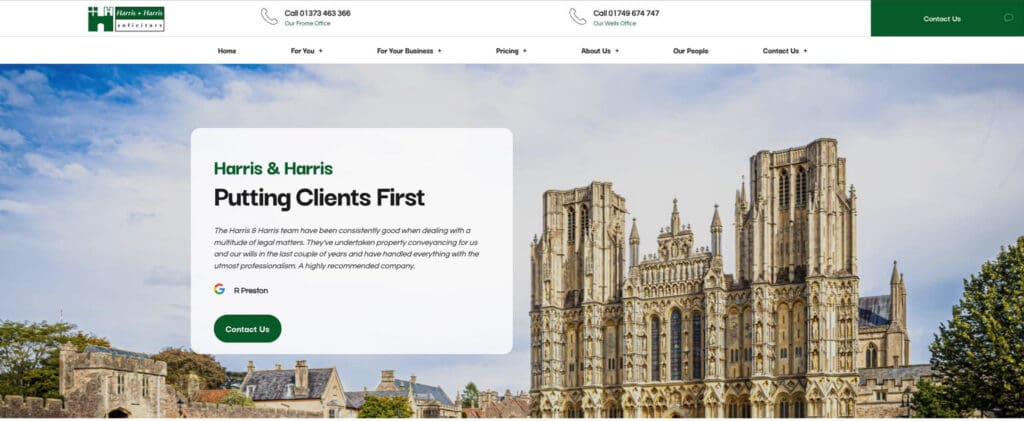A modern, professional website serves as your digital business card, showcasing your expertise and establishing credibility before clients ever walk through your door. However, many law firms unknowingly damage their reputation by maintaining outdated websites that fail to meet contemporary standards and client expectations.
An outdated website design doesn’t just look unprofessional—it actively undermines your firm’s credibility and can cost you valuable clients. In an industry where trust and competence are paramount, your website’s appearance and functionality send powerful signals about your practice’s attention to detail, technological savvy, and commitment to excellence. When potential clients encounter a website that feels stuck in the past, they may question whether your legal expertise is equally outdated.
The Signs of an Outdated Law Firm Website
Obsolete Design Elements
Many law firm websites still feature design elements that immediately date them to earlier decades. Flash animations, which were popular in the early 2000s, no longer function on most modern browsers and devices. Websites that rely on Flash appear broken to visitors and signal that the firm hasn’t updated its technology in years.
Poor typography choices, such as overuse of serif fonts in digital formats or inconsistent font sizing, create an unprofessional appearance that detracts from your message. Colour schemes that rely heavily on gradients, excessive use of bright blues and golds, or outdated colour combinations can make your website look like a relic from the internet’s early days.
Slow Loading Times
Website speed has become a critical factor in user experience and search engine rankings. Law firm websites that take more than three seconds to load will lose a significant portion of potential clients who simply won’t wait. Slow loading times often result from oversized images, outdated code, or hosting on inadequate servers.
The legal industry particularly suffers from this issue because many firms built their websites years ago and have never optimised them for modern performance standards. Each second of delay can result in lost opportunities as impatient users navigate to competitors’ faster sites.
Lack of Mobile Responsiveness
With over 60% of web traffic now coming from mobile devices, a website that doesn’t adapt to different screen sizes is essentially turning away the majority of potential clients. Non-responsive law firm websites force mobile users to pinch and zoom to read content, creating a frustrating experience that reflects poorly on the firm’s attention to client needs.
Mobile responsiveness isn’t just about shrinking content to fit smaller screens—it requires thoughtful redesign of navigation, contact forms, and information hierarchy to work effectively on touch devices. Law firms without mobile-responsive websites appear out of touch with modern client expectations.
Broken Links and Outdated Content
Nothing damages credibility faster than broken links, outdated biographical information, or practice area descriptions that reference old laws or procedures. Many law firm websites contain “News” sections with articles from years ago, profiles for solicitors who no longer work at the firm, or links to resources that no longer exist.
Outdated content extends beyond just old dates—it includes references to superseded regulations, contact information for former office locations, and testimonials from clients whose cases were resolved years ago. This stale content suggests that the firm lacks attention to detail and may not stay current with legal developments.
The Impact on Reputation and Client Trust
Creating Negative First Impressions
Research shows that users form opinions about websites within 50 milliseconds of landing on a page. For law firms, this split-second judgment can determine whether a potential client views your practice as competent and trustworthy or as outdated and potentially unreliable. An antiquated website design immediately signals that your firm may not be keeping pace with current standards and practices.
The psychological impact extends beyond just visual appeal. Clients seeking legal representation are often dealing with stressful situations and need confidence that their legal practitioner is current, capable, and professional. A website that appears neglected raises questions about whether the firm provides similarly outdated legal advice and services.
Lost Leads and Clients
Every visitor who arrives at your website and immediately leaves due to poor design represents a lost opportunity. Studies indicate that 38% of users will stop engaging with a website if the content or layout is unattractive. For law firms, this translates directly to lost consultations, cases, and revenue.
The problem is compounded when considering that many legal clients research multiple attorneys before making a decision. When your competitors have modern, professional websites while yours appears outdated, you’re immediately at a disadvantage in the comparison process. Potential clients may assume that the firm with the more professional web presence is more successful, experienced, or competent.
Trust Building in the Legal Sector
The legal profession depends heavily on trust and credibility. Clients need to believe that their solicitor is competent, reliable, and capable of handling their legal matters effectively. An outdated website undermines this trust by suggesting that the firm doesn’t pay attention to important details or stay current with professional standards.
In the legal sector, where clients often make decisions based on referrals and reputation, a poor website can damage word-of-mouth marketing. Clients and referral sources may share their impressions of your firm’s web presence, potentially impacting professional relationships and future business opportunities.
How to Update Your Law Firm's Website
Benefits of Professional Web Design
Investing in professional web design provides numerous advantages beyond just improved aesthetics. A professionally designed website incorporates modern user experience principles, ensuring that visitors can easily find the information they need and take desired actions like scheduling consultations or contacting your firm.
Professional designers like the specialists at Dentons Digital understand the unique needs of law firms, including the importance of conveying authority and trustworthiness while making complex legal information accessible to potential clients. They can create sites that effectively balance professional credibility with user-friendly functionality.
Tips for Modernizing Website Design and Functionality
- Start with a clean, contemporary design that prioritizes readability and ease of navigation.
- Choose a professional colour palette that reflects your firm’s brand without relying on outdated colour combinations.
- Implement clear typography hierarchies that make content easy to scan and digest.
- Ensure your website is fully responsive across all devices, with particular attention to mobile functionality.
- Include modern features like online appointment scheduling, live chat capabilities, and contact forms that work seamlessly on all platforms.
- Optimize images and code to ensure fast loading times across all devices and connection speeds.
- Create clear navigation paths that help visitors quickly find information about your services, attorney credentials, and contact details.
- Implement search functionality to help users locate specific information quickly.
- Include strategic calls-to-action that guide visitors toward contacting your firm or scheduling consultations.
Importance of Keeping Content Current
Establish a regular content update schedule to ensure that all information on your website remains current and accurate. This includes solicitor’s biographies, practice area descriptions, office locations, and contact information. Regularly review and update your firm’s news section with fresh content that demonstrates your ongoing expertise and involvement in the legal community.
Build your site on a platform like WordPress, which gives you a content management system that makes it easy to update information without requiring technical expertise.
Train staff members to recognise outdated content and establish procedures for regular content audits. Consider adding a blog or news section that showcases your firm’s expertise and helps with search engine optimisation.
Real-World Examples
Examples of Effective Law Firm Websites
Modern law firm websites feature clean, professional designs with clear navigation and strategic use of white space. They include high-quality professional photography, easy-to-read typography, and intuitive information architecture. Effective sites prominently display solicitor’s credentials, clearly describe practice areas, and include multiple ways for potential clients to make contact.
This website built by Dentons Digital is a typical example of a well-crafted website that works on all levels for the firm Harris & Harris, based in Wells, Somerset.

Common Mistakes to Avoid
Outdated law firm websites often feature cluttered layouts with too much information competing for attention. They may use stock photography that looks generic or unprofessional, or include outdated images that don’t reflect the current state of the firm. Poor navigation structures force visitors to click through multiple pages to find basic information.
Many outdated sites include auto-playing music or videos, excessive animation, or pop-ups that interrupt the user experience. They may have inconsistent branding, outdated logos, or colour schemes that don’t align with current professional standards. Technical issues like broken forms, slow loading times, or mobile compatibility problems are common warning signs of outdated design.
Don’t let an outdated website undermine the quality legal services you provide. Take action today to evaluate your current web presence and invest in the professional, modern website your firm deserves. Your future clients—and your firm’s reputation—depend on it. Schedule a consultation with a digital agency that understands the unique needs of a law firm when it comes to their online presence.




